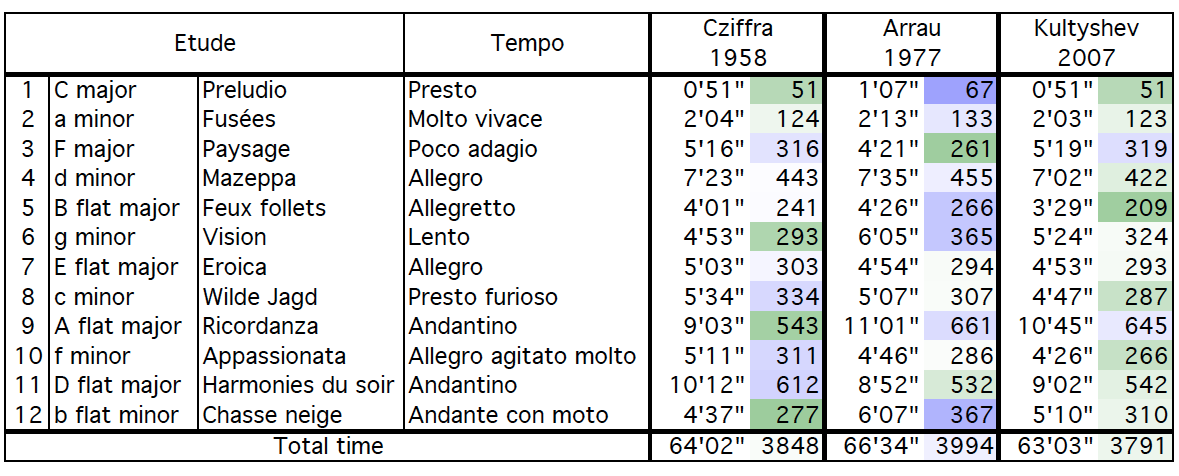Franz Liszt
Etudes d’exécution transcendente, S.139
Media Review / Comparison
2012-04-25 — Original posting (on Blogger)
2013-07-16 — New standard layout applied
2014-11-02 — Re-posting (WordPress) with minor enhancements (table)
2016-06-26 — Brushed up for better readability
Table of Contents
The Recordings
Just a brief note on three recordings of the 12 Etudes d’exécution transcendante, S.139 by Franz Liszt (1811 – 1886). I’m not doing a detailed analysis, as I don’t have the scores. Here are the recordings that I listened to:
- György Cziffra (1958)
- Claudio Arrau (1977)
- Miroslav Kultyshev (2007)
A Comparison of Durations
In the chart above I have listed the track durations, both in minutes (mm’ss”) and in seconds, for these three artists. No rating is intended with this. The color background in the “seconds only” columns indicates duration deviations from the average (among these three recordings). Blue indicates tracks which are longer / slower than the average, green stands for tracks that are shorter / faster than the average:
Again: no rating intended here — this is not a speed race (even though these pieces must be a feast for the top virtuosi of this world!). All I mean to say with this table — given the limited number of artists — is:
- György Cziffra has 3 pieces (and many passages, see below) where he plays substantially faster than the other two. There are also 3 pieces where he plays slower overall.
- Claudio Arrau plays substantially slower in 5 Etudes. The one Etude where he is faster (Nr.3) is the most lyrical among the twelve;
- Miroslav Kultyshev is never really slow, but fast(er) in four Etudes.
Note: the above times are formal track durations, including dead times.
Comments on the Performances
Georges Cziffra, 1958
Liszt: Oeuvres pour piano
EMI Classics 0946 367551 2 0 (5 CDs, mono / stereo); ℗ 1957 – 1986
digital remastering ℗ 2001 / © 2006

György (Georges) Cziffra (1921 – 1994) recorded the Etudes d’exécution transcendante in 1958 — a mono recording. This is part of a collection of 5 CDs with Liszt-recordings by Cziffra, dating between 1956 and 1985. Besides these Etudes, the collection includes the Hungarian Rhapsodies, Rhapsodie Espagnole, Mephisto Waltz, Sonata in B minor, and various other pieces for piano solo. The presence of this recording is almost accidental. It represents “collateral benefit” of a purchase of Liszt’s Hungarian Rhapsodies that I already had on vinyl. With Cziffra being such a fascinating artist, this was more than a welcome extra, along with the Sonata in B minor and many other Liszt highlights.
What’s in this recording of the Etudes, then? Well, Cziffra was the prototype of a “supervirtuoso” — a “species” of which there are and have been only a handful in the history of the piano so far — artists with technical abilities which appear to be a class above anybody else. From today’s pianists, artists such as Marc-André Hamelin, Arcadi Volodos, and Denis Matsuev come to mind.
Cziffra recorded these Etudes when he was 37 — at the height of his phenomenal abilities. Listening to his recordings is like watching a top circus artist — I can’t think of anybody else who can play octave parallels so fast and yet so precise (almost like with “steel hands”). He features rapid jeu perlé, extremely rapid passages, etc. — and then, there’s his Hungarian temperament! For me, the latter “works best” in the Hungarian Rhapsodies, which offer a platform for his characteristic “Cziffra stringendi“!
The Performance
Like the Hungarian Rhapsodies, these Etudes were definitely showpieces for Liszt’s virtuosity. However, I feel they also have their lyrical aspects, and for me they are also “less Hungarian” than the Rhapsodies. I therefore feel that the Etudes are not the best platform for Cziffra’s stringendi. Yet, Cziffra does not leave out a single opportunity for showing off his virtuosity, even “beefing up” Liszt’s text with extra octave doublings, additional notes in general.
Often he appears to play without or with very little pedal, “over-pronouncing” his octave passages with staccato, and more. His artistry is jaw-dropping, reaching up to and beyond the limitations of the instrument and its mechanics! But I feel that this leaves a few shortcomings in his interpretation: the lyrical aspect of these pieces is often not covered at all, the musical flow isn’t always “organic”. Plus, one could probably argue that at Liszt’s time the dampening of the piano was much weaker, i.e., Liszt simply did not have the means to play piano the way Cziffra did with his dry staccati.
| Recommendation: | A fascinating performance, but definitely not comparable to any other recording, nor anywhere close to a “standard interpretation”. Cziffra fans will buy that CD set anyway (a “must have” for fans!). I can recommend it, but I’d complement it with Kultyshev’s recording, see below! |
| Rating: | 4 |
Claudio Arrau, 1977
Liszt: 12 Etudes d’exécution transcendante
Claudio Arrau
Philips Classics 416 458-2 / iTunes download (256 Kbps); ℗ 1977

Claudio Arrau (1903 – 1991) recorded the Liszt Etudes in 1977.
Back in the vinyl days, this was my only recording of these Etudes, recorded by Arrau at the age of 74 — an amazing achievement with these pieces.
The Performance
Actually, this recording not only is an excellent achievement for a pianist of that age, but it is a very respectable performance overall. It’s certainly competitive with — or close to — other, “conventional” / “classic” interpretations. So: it’s a good interpretation — but in my opinion, Kultyshev clearly beats it. I can’t judge whether the “missing bit” is Arrau’s interpretation, or whether his technical abilities were giving in.
An indication for the latter possibility is that there are instances where he slightly takes back the tempo, in places where Cziffra would maybe even speed up, or push forward to “jumping the keyboard”. With Cziffra one often almost falls off the chair in awe for his artistry — here, one can feel how difficult the music is, technically. I don’t mean to say that Arrau doesn’t master the text, but it’s possible or perhaps likely that he sometimes adjusted the tempo to his technical abilities.
| Recommendation: | A good “classic” interpretation — definitely very good for a pianist of his age, also given the huge size of Arrau’s repertoire! |
| Rating: | 3.5 |
Miroslav Kultyshev, 2007
Liszt: 12 Etudes d’exécution transcendante
Orfeo C 759081 A (stereo); ℗ / © 2008

Miroslav Kultyshev (*1985) recorded these Etudes in 2007.
My first encounter with this artist was through the live webcasts of the Warsaw Chopin competition in 2010. My impression then was that of a shy, nervous, possibly fragile personality. He played very well, and certainly deserved being among the top ten in this competition, even though he did not stand a chance against Yulianna Avdeeva’s strong musical personality, her vivid, expressive style and interpretation.
A Radio Comparison
A couple of months ago, I listened to a podcast of a local radio feature (“Diskothek im Zwei”, DRS2), where two musicians did a blind comparison of various recordings of Liszt’s Etudes d’exécution transcendante. They covered recordings by Jorge Bolet, Claudio Arrau, Miroslav Kultyshev, Alice Sara Ott, and Vesselin Stanev (excerpts from recordings by Ferruccio Busoni and György Cziffra were also played, for reference).
I was surprised to see Miroslav Kultyshev listed with a recording that was done 3 years prior to the Chopin competition in Warsaw. I was even more surprised to see that he came out pretty well in this radio comparison. So, I decided to add this recording to my modest collection (with the above two recordings), and to do a comparison myself.
In the radio comparison, all interpretations under discussion were judged to be at a very high level. Stanev and Cziffra came out on top of the list, followed by Ott and Kultyshev, though. Note, that the radio comparison is much more fragmentary than this one, and often the winner depends on the choice of movements / pieces played. Whoever fails in the first round is “out”, the scope of artists is narrowing with every round. On the other hand, I’m not a pianist, and I did not follow the score, so my judgement is to be taken with a pinch of salt…
The Performance
For me, Kultyshev not only fully masters the enormous difficulties in these Etudes, but in his interpretation, technical mastership and virtuosity become mere means of expression. In his hands, these pieces appear more emotional and expressive than the other two. Especially compared to Cziffra, his playing is much more legato. Despite all the technical challenges he manages to expose the lyrical aspects in many of these Etudes. In Etudes that are more lyrical, especially Nr.11 (“Harmonies du Soir”), his playing is so narrative that it reminds me of the poetic “interaction” between Eusebius, Florestan and the poet in Schumann’s “Kinderszenen” op.15!
Kultyshev’s interpretation appears more natural, more harmonic than the other two, focusing on musical flow, gradual build-up to the culmination point(s), and he rarely ever appears to expose sheer virtuosity and brilliance — I like this interpretation!
| Recommendation: | Yes, absolutely — but having this interpretation should not stop you from listening to Cziffra… |
| Rating: | 5 |
Conclusion
Cziffra leaves the listener in awe about his technical abilities and his virtuosity. His interpretation emphasizes and demonstrates the extreme technical difficulties in these pieces. Arrau makes the listener realize the challenges in these compositions. With Kultyshev I like the expressivity, the natural flow, the focus on the emotional content. His interpretation is less extroverted (and emotionally more controlled) than Cziffra’s.








